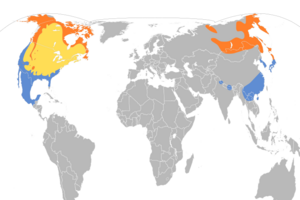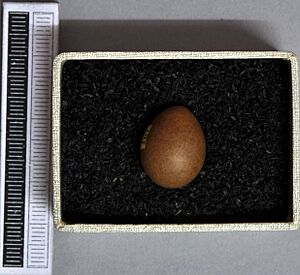Buff-bellied pipit facts for kids
Quick facts for kids Buff-bellied pipit |
|
|---|---|
 |
|
| Nominate subspecies in Oregon, USA | |
| Conservation status | |
| Scientific classification | |
| Genus: |
Anthus
|
| Species: |
rubescens
|
 |
|
| Synonyms | |
|
Anthus pensilvanicus |
|
The buff-bellied pipit or American pipit (Anthus rubescens) is a small songbird. It lives on both sides of the northern Pacific Ocean. Marmaduke Tunstall first described this bird in 1771. He wrote about it in his book Ornithologia Britannica. This bird was once thought to be a type of water pipit. In North America, people call it the "American pipit". In Europe and Asia, it is known as the "buff-bellied pipit".
Contents
What Does the Buff-Bellied Pipit Look Like?
Like most other pipits, the buff-bellied pipit does not have bright colors. It usually runs around on the ground.
Different Types of Buff-Bellied Pipits
There are two main groups of this bird. They look a bit different.
The American Pipit
The rubescens group is often called the American pipit. These birds have grey-brown feathers on their upper parts. These feathers have light streaks. Their chest and sides are buff-colored with faint streaks. Their belly is whitish. Both their beak and legs are dark.
The Japanese Pipit
The japonicus group is also known as the Japanese pipit. These birds are darker on top. They have stronger black streaks on their whiter undersides. Their legs often have a reddish color.
How Big Are They?
- Length: 16 cm (about 6 inches)
- Weight: 22 grams (about 0.8 ounces)
- Wingspan: 24 cm (about 9.5 inches)
What Sound Do They Make?
Their call is a squeaky sip sound.
Understanding the Buff-Bellied Pipit's Name and Family
The scientific name for this bird comes from Latin. Anthus is a Latin name for a small grassland bird. The word rubescens means "reddish." It comes from ruber, which means "ruddy."
Different Subspecies of Pipits
Scientists currently recognize four different types, or subspecies, of the buff-bellied pipit. These four types belong to two main groups. They have clear differences in their looks and DNA. Some scientists think they might even be separate species. More research is needed to be sure.
- A. r. rubescens (Tunstall, 1771) – This is the American pipit. It breeds in northern Canada, Greenland, and the northeast United States. It spends winter in Central America.
- A. r. pacificus (Todd, 1935) – This type breeds along the Pacific mountains. This area stretches from Alaska to Oregon. It winters in western Mexico.
- A. r. alticola (Todd, 1935) – This pipit breeds in the Rocky Mountains. Its breeding range goes from southern British Columbia to California. It winters in Mexico.
- A. r. japonicus (Temminck & Schlegel, 1847) – This is the Japanese pipit or Siberian pipit. It breeds across most of eastern Asia, including Japan.
Related Pipit Species
The buff-bellied pipit is closely related to the European rock pipit (A. petrosus) and the water pipit (A. spinoletta). In the past, all three were considered the same species. You can tell them apart by their calls and how they look. Rock pipits and buff-bellied pipits usually do not live in the same areas. The ranges of buff-bellied and water pipits only overlap a little in Central Asia.
How Do Buff-Bellied Pipits Live?
Both types of buff-bellied pipits are migratory. This means they travel long distances between their breeding and wintering grounds.
Where Do They Travel?
The buff-bellied pipit spends winter on the Pacific coast of North America. It also winters on the Atlantic coast, from the southern United States to Central America. In the 1900s, this bird started to winter further north. They also seem to spend less time in their winter homes. For example, in northern Ohio, they used to be rare during migration. Now, many birds winter there.
Asian buff-bellied pipits mainly winter from Pakistan east to Southeast Asia. Some are found in Yunnan, China. A few in Japan might stay all year or only migrate a short distance. Sometimes, American pipits are seen in Western Europe. Asian pipits are sometimes seen in Eastern Europe. These are rare sightings.
What Do They Eat?
Like their relatives, these birds are insectivorous. This means they mostly eat insects.
Where Do They Live?
During the breeding season, buff-bellied pipits live in tundra areas. Outside of breeding season, they live in open areas with light plant growth. These places are similar to where the water pipit lives.
Life Cycle: From Egg to Young Bird
When buff-bellied pipits arrive at their breeding sites, the snow is melting. This is when they find a partner. Males will fight each other to win a female. They also fight for snow-free spots that are good for nesting. The melting snow also means more insects are available. Insects are the main food for these birds.
Building a Nest
After finding a partner, the next step is building a nest. Nests are usually on the ground in dry or wet meadows. They are always in a spot that offers some protection. They never build nests in bushes or trees. The nest is made from whatever is nearby. This often includes sedge, old or new fine grass, and sometimes horse hairs.
Laying Eggs
The female will only lay an egg if conditions are perfect. This includes the right temperature and a good nesting spot. If her first attempt to lay an egg fails, she has less time to try again. Generally, buff-bellied pipits lay eggs for 4 to 5 days after the snow melts. This happens from April to May, and continues until mid-July. After mid-July, the male's body changes, and the female stops laying eggs.
A female usually lays 5 eggs. But this number can change. It depends on how much it snows, the parents' ability to reproduce, and if predators are around.
Incubation and Hatching
The eggs are kept warm, or incubated, for 13 to 14 days. During this time, the female stays on the nest. She is very aware of any movement nearby. She sings to the male, who brings her food and protects their territory.
Caring for Young Birds
Four or five days after hatching, the young birds are small and blue-gray. They only have their secondary feathers. For one week, the female will keep the young birds warm. Both parents will feed them. After 7 days, the young birds are ready to leave the nest. But their parents will still feed them for 14 more days. Finally, young birds will form small groups with other young birds and explore on their own.
Is the Buff-Bellied Pipit in Danger?
The buff-bellied pipit is a common bird. It is found in many places. The IUCN (International Union for Conservation of Nature) does not consider it to be threatened.



